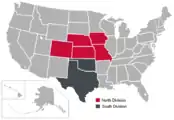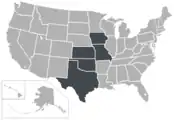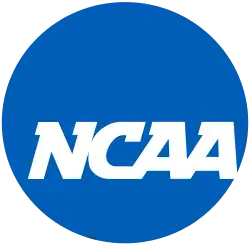2010–13 Big 12 Conference realignment
The 2010–13 Big 12 Conference realignment refers to the Big 12 Conference (Big 12) dealing with several proposed and actual conference expansion and reduction plans among various NCAA conferences and institutions. Part of the larger NCAA conference realignment, beginning in the 2010–11 academic year and continuing to the present, the Big 12 was one of the more severely impacted conferences. In all, four schools have departed (Colorado, Missouri, Nebraska, Texas A&M) and two have joined (West Virginia, TCU).

First wave
Nebraska announced that it would leave the Big 12 Conference for the Big Ten Conference effective in 2011.[1][2]
Colorado also announced a change in conference alignment; originally planning to transfer to the Pac-10 for the 2012–13 season, the school agreed to depart a year early after Nebraska announced its plans to depart the conference in 2011.[3]
With the loss of Colorado (who had been a member of the Big 12 and its predecessor the Big Eight Conference since 1947) to the Pac-10 and Nebraska (whose association with the Big 12 dates back to the 1907 founding of what was to become the Big Eight) to the Big Ten, the Big 12 was reduced to ten teams and faced more possible attrition.
Other Big 12 schools were rumored to be candidates for expansion by other conferences, including further expansion by the Pac-10 or Big Ten.[4] Speculation and rumors centered on Texas, Texas Tech, Oklahoma, and Oklahoma State following Colorado to the Pac-10. Texas A&M was also considered as a PAC-10 candidate but was also reportedly considering a move to the SEC.
ESPN reported on June 11 that Texas, Texas Tech, and the two Oklahoma schools were prepared to accept an invitation from the Pac-10. The report also indicated that Texas A&M was torn between the Pac-10 and SEC and was given a 72-hour deadline to decide on its future destination.[5][6] Meanwhile, Baylor announced that it would wait and see what the final outcome of the Big 12's realignment would be before making any final decision concerning where they would go if the Big 12 dissolved. On June 14, ESPN, citing sources within the Big 12, initially reported that Texas, Texas Tech, Oklahoma, and Oklahoma State would join the Pac-10 no later than June 15, while Texas A&M was now most likely to opt for the SEC.[7] The remaining Big 12 schools Baylor, Iowa State, Kansas, Kansas State, and Missouri may have been left to find new leagues, with early speculation pointing to a possible move for some of those schools to the Mountain West or Big East conferences.[5] Kansas men's basketball coach Bill Self stated, on the day that TCU announced its entry into the Big East, that had the Big 12 collapsed the Big East would have offered membership to Kansas, Kansas State, Iowa State, and Missouri.[8]
On June 14, reports started surfacing that the almost certain departure of Texas (and, along with them, several other schools) from the Big 12 would not happen. Indications were that a last-minute effort by Big 12 Commissioner Dan Beebe to hold the 10-remaining Big 12 teams together might be successful. Beebe's plan showed that the remaining 10 schools could nearly double their television revenue if they stick with the Big 12.[9] In addition, Beebe said that Texas would be allowed to start its own network if the school stayed with the Big 12—a business move that Texas has wanted to do that would not be allowed in the Pac-10. If Texas decided to stay with the Big 12, that had the potential to effectively end any further realignment in the NCAA, save for one or two moves in the Pac-10 and Mountain West Conference.[9] However, others were saying that while Texas might want to keep the Big 12 together with this deal, the remaining Big 12 South teams that were considering departing the Big 12 (Texas Tech, Texas A&M, Oklahoma and Oklahoma State) would not be interested in a deal that would give a school that already has a competitive advantage an even larger one.[10]
Later that day, Andy Katz of ESPN.com, citing an NCAA source with direct knowledge of the negotiations, reported that many prominent figures inside and outside of college athletics, many of whom had no direct stake in their outcome, had worked to broker a deal that would satisfy Texas and keep the Big 12 viable with 10 members. The group believed that the Pac-10 approach was not in the best interest of the schools involved. In the end, Texas would decide to stay in the truncated Big 12, with the remaining Big 12 South schools pledging their support for the conference shortly thereafter.[11] The Pac-10 was still seeking a 12th member to join with Colorado; early speculation focused on Mountain West member Utah as the next Pac-10 expansion target.[12]
On June 17, twenty-six Texas legislators, spearheaded by Garnet Coleman and Bill Callegari, from the Houston area co-authored an open letter to the Big 12 that asked the conference to consider adding Houston as a member.[13][14][15][16]
Second wave
In July 2011, the Texas A&M Board of Regents met to discuss the long-term impact of the Longhorn Network, a new TV channel devoted to Texas Longhorns sports that was set to launch a month later. Shortly before the meeting, an official of ESPN, partners with Texas in the network, gave a radio interview in which he strongly hinted that the network would also televise high school games of potential Longhorns recruits. (Texas operates the University Interscholastic League (UIL), the governing body for public school athletics in the state.)
According to Sports Illustrated writer Andy Staples, the Longhorn Network broadcasting high school games (to the potential benefit of Texas and the detriment of the conference's other Texas-based schools) "was too much [for A&M] to bear." Though the Big 12 made new rules to stop the high school telecasts (and the NCAA would ultimately declare that such broadcasts would be considered in violation of recruiting rules), the Regents decided to pursue an invitation to the Southeastern Conference,[17] which had been considered the prior year during realignment discussions involving the Big 12 and the Pac-12.
A&M announced on August 31, 2011 that it would leave the Big 12 in June 2012 to join the SEC,[18] but the invitation process was prolonged by various moves by the Big 12, which feared that A&M's departure would scuttle the conference. Most notably, Baylor president Ken Starr threatened legal action if the SEC invited A&M.[17] In early September, the SEC issued a formal invitation to Texas A&M, but it was dependent on the Big 12 and its members dropping any potential lawsuits related to the move. The SEC invitation was not final until September 25. By this time, the Big 12 was already pursuing TCU as a replacement for Texas A&M.[17]
On October 6, 2011, the conference announced that it had invited TCU, with the school's acceptance coming four days later. The Horned Frogs would join the Big 12 on July 1, 2012.[19]
On October 28, 2011, the conference formally invited West Virginia to join.[20] The university accepted the invitation the same day, and also became a full member effective July 1, 2012. The conference's press release also hinted at Missouri's imminent departure, as it was not listed among the "expected" ten members for the 2012–13 school year.[21]
Nine days later, on November 6, 2011, the SEC officially announced that it had added Missouri as its 14th member.[22]
Later developments
West Virginia's entry into the Big 12 was held up by a legal dispute between the school and the Big East Conference, which sought to enforce a 27-month waiting period included in the league's bylaws. The dispute was settled on February 14, 2012, with the Big 12 and WVU paying a combined $20 million.[23]
The next move for the conference was to attempt to find stability in an upgraded TV deal. Before the realignment, the Big 12 had a contract with ESPN and ABC that ran through the 2016 season, and had signed a deal with Fox that would start in 2013 and run through 2025.[24] The Big 12 then negotiated an extension to the ESPN/ABC deal that brought its ending date to 2025 to match the Fox deal. Combined, the two deals will reportedly give the conference a total of $2.6 billion, which translates to $20 million per year for each school if the conference remains at 10 members. More significantly for the stability of the conference, the deal also includes an extension of the league's grant of rights from six to 13 years, to match the duration of the new contract. This means that if a school leaves the Big 12 during the term of the newly extended contract, the league will keep all of that school's broadcast revenues for the duration.[25] It was also reported that the Big 12 may try to expand further, although few candidates were available that would add value to the new TV deal. Big East member Louisville was interested in moving to the Big 12, but later accepted an invitation to join the ACC.[25][26]
In May 2012, several Florida State University figures sent decidedly mixed messages about that school's future in the ACC, expressing at least some interest in a move to the Big 12. First, on May 12, as the ACC's annual spring meetings were about to begin, the chairman of the school's board of trustees, Andy Haggard, blasted the conference's newest media rights deal, telling an FSU fan site that the school "unanimously" favored "seeing what the Big 12 might have to offer". However, his statement was inaccurate on some key points of the deal.[27][28] On the same day, head football coach Jimbo Fisher told the Orlando Sentinel, "There have been no official talks, but I think you always have to look out there to see what's best for Florida State. If that [jumping to the Big 12] is what's best for Florida State, then that's what we need to do."[27] In the meantime, FSU president Eric Barron sent out a statement from his email account that listed four reasons to move to the Big 12, followed by seven reasons why FSU should stay in the ACC.[27] Barron also took a dig at the Big 12, saying that the school's faculty considered it "academically weaker" than the ACC.[28] The mixed messages continued in the following days. Former FSU football All-American Derrick Brooks, also a former member of the FSU board of trustees, appeared on the Tim Brando Show, a national sports talk program, and claimed that the Big 12 was actively pursuing Florida State.[28] All this led CBS Sports' Tony Barnhart to state that "the speculation on Florida State's future is at DEFCON 1."[28] Finally, when FSU athletic director Randy Spetman was asked for comment on the rumors surrounding the school's future plans, all he said was "I don't know how Derrick got that."[28]
After the Big 12 was shut out of the initial College Football Playoff in 2014 despite TCU and Baylor finishing as co-champions at 11–1, there was speculation that the Big 12 might expand back to 12 teams (or more) in order to host a conference championship game.[29] Teams speculated to join include Boise State, BYU, Central Florida, Colorado State, and Memphis, as well as schools closer to West Virginia to give the Big 12 a potential East Division such as Cincinnati.[30] Ultimately, NCAA rules were changed to allow conferences to hold a championship game with only 10 teams causing the drive for further expansion to abate.[31]
Membership changes
| School | Sport(s) | Former conference | New conference | Date move was announced | Year move took effect |
|---|---|---|---|---|---|
| Colorado Buffaloes | Full membership | Big 12 | Pac-12 | June 10, 2010 | 2011[32] |
| Nebraska Cornhuskers | Full membership | Big 12 | Big Ten | June 11, 2010 | 2011[33] |
| Texas A&M Aggies | Full membership | Big 12 | SEC | August 31, 2011 | 2012[18] |
| TCU Horned Frogs | Full membership | Mountain West[34] | Big 12 | October 10, 2011 | 2012[19] |
| West Virginia Mountaineers | Full membership | Big East | Big 12 | October 28, 2011 | 2012[20][21] |
| Missouri Tigers | Full membership | Big 12 | SEC | November 6, 2011 | 2012[22] |
| West Virginia Mountaineers | Wrestling | Eastern Wrestling League | Big 12 | April 9, 2012 | 2013 |
| Missouri Tigers | Wrestling | Big 12 | MAC | September 19, 2012 | 2012[35] |
Gallery of Big 12 membership changes
 A map of the Big 12 as it existed from 1996 to 2011, with North (red) and South (grey) divisions
A map of the Big 12 as it existed from 1996 to 2011, with North (red) and South (grey) divisions
 The Big 12 as it has existed since 2012, after the departures of Texas A&M and Missouri and the additions of Texas Christian and West Virginia
The Big 12 as it has existed since 2012, after the departures of Texas A&M and Missouri and the additions of Texas Christian and West Virginia
See also
References
- Kerkhoff, Blair (June 11, 2010). "Nebraska bolts for the Big Ten". kansascity.com. Archived from the original on 14 June 2010. Retrieved June 11, 2010.
- Associated Press (June 11, 2010). "Nebraska approved by Big Ten". ESPN.com. Archived from the original on 13 June 2010. Retrieved June 11, 2010.
- "Colorado leaves Big 12 for Pac-10". ESPN.com. June 11, 2010. Retrieved June 11, 2010.
- "Sources: Texas, Tech, Oklahoma, OSU to Pac-10; Scott to deliver invitations this weekend". SportsDay DFW Powered by The Dallas Morning News. June 11, 2010. Archived from the original on 2011-07-08. Retrieved June 11, 2010.
- "Texas considers 'all options'". San Francisco Chronicle. 2010-06-13.
- "Source: UT, 3 others poised for Pac-10". ESPN.com. June 11, 2010. Archived from the original on 13 June 2010. Retrieved June 12, 2010.
- Schad, Joe (June 14, 2010). "Sources: Departure to Pac-10 coming". ESPN.com. Archived from the original on 16 June 2010. Retrieved June 14, 2010.
- Jacobi, Adam (2010-11-30). "Self: Big East was set to take Kansas, others". CBS Sports. Archived from the original on July 8, 2011. Retrieved May 20, 2011.
- Brown, Chip (June 14, 2010). "Remaining schools in Big 12 trying to save league". Orangebloods.com. Retrieved June 14, 2010.
- Nusser, Jeff (June 14, 2010). "PAC-10 EXPANSION: Is Texas really wavering?". CougCenter.com. Retrieved June 14, 2010.
- Katz, Andy (June 14, 2010). "Source: Influential group saved Big 12". ESPN.com. Retrieved June 14, 2010.
- "Texas move helps Big 12 survive". ESPN.com. June 14, 2010. Archived from the original on 17 June 2010. Retrieved June 14, 2010.
- "Texas lawmakers pushing depleted Big 12 to add Houston". CBS Sports. 2010-06-17. Retrieved 2010-09-13.
- "Texas lawmakers want Houston in Big 12, Jerry Jones wants Arkansas, Notre Dame". USA Today. 2010-06-17. Retrieved 2010-09-13.
- Campbell, Steve (2010-06-17). "Legislators make their pitch for UH spot in Big 12". Houston Chronicle. Retrieved 2010-09-13.
- "Lawmakers supporting Houston bid to join Big 12". The Dallas Morning News. 2010-06-17. Retrieved 2010-09-13.
- Staples, Andy (July 5, 2012). "TCU finally in Big 12". Inside College Football. Sports Illustrated. p. 2. Retrieved July 5, 2012.
- "Texas A&M announced departure of Big 12" (Press release). Texas A&M University. August 31, 2011. Archived from the original on November 16, 2011. Retrieved August 31, 2011.
- "TCU Accepts Invitation To Join Big 12 Conference". TCU Athletic Department. October 10, 2011. Archived from the original on October 12, 2011. Retrieved February 9, 2013.
- ESPN.com news services (2011-10-28). "West Virginia Mountaineers formally invited to join Big 12". Retrieved 2011-10-29.
- "West Virginia University To Join Big 12 Conference" (Press release). Big 12 Conference. 2011-10-28. Retrieved 2011-10-30.
- http://espn.go.com/college-sports/story/_/id/7199062/missouri-tigers-move-sec-official-big-12-hurdles-remain
- Adelson, Andrea (February 14, 2012). "WVU settles suit, to join Big 12 in July". ESPN.com. Retrieved February 14, 2012.
- Dodd, Dennis; McMurphy, Brett (March 18, 2012). "Big 12 negotiating media rights deal worth at least $2.6 billion". CBSSports.com. Retrieved May 10, 2012.
- Dodd, Dennis (May 7, 2012). "Big 12 verbally agrees to new ESPN/Fox deal". College Football Insider. CBSSports.com. Retrieved May 10, 2012.
- McMurphy, Brett. "Louisville Headed to ACC". ESPN. Retrieved 29 November 2012.
- McMurphy, Brett (May 15, 2012). "Florida State isn't leaving the ACC for the Big 12 ... at least not today". College Football Insider. CBSSports.com. Retrieved May 15, 2012.
- Barnhart, Tony (May 18, 2012). "Wherever Florida State lands, its reps need to get on same page". CBSSports.com. Retrieved May 18, 2012.
- Big 12 commish: Consider new model ESPN.com (12/07/2014)
- UC-Big 12 speculation heats up Cincinnati.com (12/07/2014)
- https://www.cbssports.com/college-football/news/big-12-approves-return-of-conference-championship-game-for-football-in-2017/
- "Terms for Colorado Withdrawal From Big 12 Announced". Big 12 Conference. Retrieved September 21, 2010.
- "University of Nebraska asks regents to approve move from Big 12 to Big Ten". usatoday.com. 2010-06-11.
- TCU, after announcing its departure from the Mountain West to the Big East, later accepted an invitation to join the Big 12. TCU joined the Big 12 in 2012 without ever officially joining the Big East.
- "MAC adds wrestling members" (Press release). Mid-American Conference. September 19, 2012. Archived from the original on 2012-10-20. Retrieved September 20, 2012.
